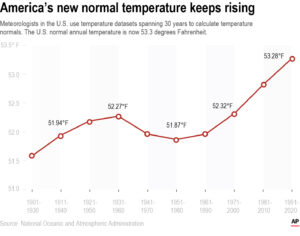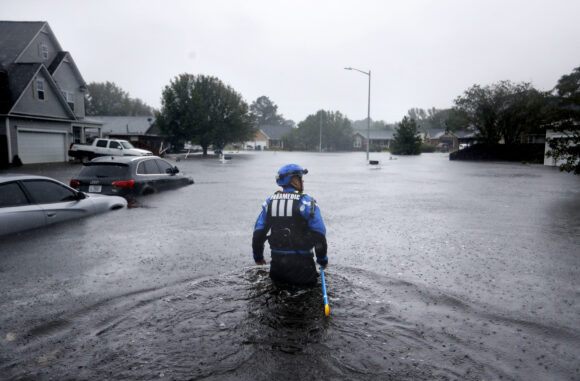America’s new normal temperature is a degree hotter than it was just two decades ago.
Scientists have long talked about climate change — hotter temperatures, changes in rain and snowfall and more extreme weather — being the “new normal.” Data released Tuesday by the National Oceanic and Atmospheric Administration put hard figures on the cliche.
The new United States normal is not just hotter, but wetter in the eastern and central parts of the nation and considerably drier in the West than just a decade earlier.
Meteorologists calculate climate normals based on 30 years of data to limit the random swings of daily weather. It’s a standard set by the World Meteorological Organization. Every 10 years, NOAA updates normal for the country as a whole, states and cities — by year, month and season.

For the entire nation, the yearly normal temperature is now 53.3 degrees (11.8 degrees Celsius) based on weather station data from 1991 to 2020, nearly half a degree warmer than a decade ago. Twenty years ago, normal was 52.3 degrees (11.3 degrees Celsius) based on data from 1971 to 2000. The average U.S. temperature for the 20th century was 52 degrees (11.1 degrees Celsius).
The new normal annual U.S. temperature is 1.7 degrees (0.9 Celsius) hotter than the first normal calculated for 1901 to 1930.
“Almost every place in the U.S. has warmed from the 1981 to 2010 normal to the 1991 to 2020 normal,” said Michael Palecki, NOAA’s normals project manager.
Fargo, North Dakota, where the new normal is a tenth of a degree cooler than the old one, is an exception, but more than 90% of the U.S. has warmer normal temperatures now than 10 years ago, Palecki said.
In Chicago and Asheville, North Carolina, the new yearly normal temperature jumped 1.5 degrees in a decade. Seattle, Atlanta, Boston and Phoenix had their normal annual temperature rise by at least half a degree in the last decade.
Charlottesville, Virginia, saw the biggest jump in normal temperatures among 739 major weather stations. Other large changes were in California, Texas, Virginia, Indiana, Arizona, Oregon, Arkansas, Maryland, Florida, North Carolina and Alaska.
New normals are warmer because the burning of fossil fuels is making the last decade “a much hotter time period for much of the globe than the decades” before, said Cornell University climate scientist Natalie Mahowald.
For Phoenix, the biggest change in normal came in precipitation. The normal annual rainfall for Phoenix dropped 10% down to 7.2 inches (18.2 centimeters). Rainfall in Los Angeles dropped 4.6%.
At the same time, Asheville saw a nearly 9% increase in rainfall, while New York City’s rainfall rose 6%. Seattle’s normal is 5% wetter than it used to be.
Climate scientists are split about how useful or misleading newly calculated normals are.
Mahowald and University of Oklahoma meteorology professor Jason Furtado said updating normal calculations helps city and regional planners to prepare for flooding and drought, farmers to decide what and when to plant, energy companies to meet changing demands and doctors to tackle public health issues arising from climate change.
But Pennsylvania State University climate scientist Michael Mann said he prefers a constant baseline such as 1951 to 1980, which is what NASA uses. Adjusting normal every 10 years “perverts the meaning of `normal’ and `normalizes’ away climate change,” he said in an email.
North Carolina’s state climatologist Kathie Dello said, “It seems odd to still call them normals because 1991-2020 was anything but normal climate-wise.”
About the photo: In this Sunday, Sept. 16, 2018 file photo, a member of the North Carolina Task Force urban search and rescue team wades through a flooded neighborhood looking for residents who stayed behind as Florence continues to dump heavy rain in Fayetteville, N.C. According to data released by the National Oceanic and Atmospheric Administration on Tuesday, May 4, 2021, the new United States normal is not just hotter, but wetter in the eastern and central parts of the nation and considerably drier in the West than just a decade earlier. (AP Photo/David Goldman)
Was this article valuable?
Here are more articles you may enjoy.


 Surging Oil Tanker Insurance Points to Growing Black Sea Chaos
Surging Oil Tanker Insurance Points to Growing Black Sea Chaos  NYC Sues Delivery App Over Lost Pay in New Mamdani Crackdown
NYC Sues Delivery App Over Lost Pay in New Mamdani Crackdown  California Governor Seeks $200M to Replace EV Tax Credits Cut by Trump
California Governor Seeks $200M to Replace EV Tax Credits Cut by Trump  First Brands Judge Approves Examiner to Probe Fraud Allegations
First Brands Judge Approves Examiner to Probe Fraud Allegations 